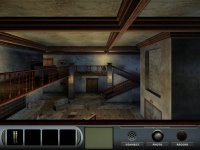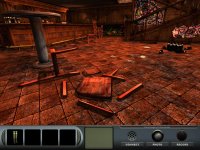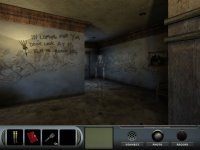Delaware St. John 1 review
 You play Delaware St. John, a supernatural detective who must hate his parents for naming him after a state known mainly for being the top choice for new companies’ incorporation. But since Indiana and Dakota were already taken, there weren’t too many choices left. I mean, who in their right mind would name their son “
You play Delaware St. John, a supernatural detective who must hate his parents for naming him after a state known mainly for being the top choice for new companies’ incorporation. But since Indiana and Dakota were already taken, there weren’t too many choices left. I mean, who in their right mind would name their son “
 The game is portrayed in a first person view. It all takes place in a manor, where you move and turn around in steps, instead of a smooth movement. While this may be somewhat confining, it also allowed the author to incorporate some scripted events, such as ghosts appearing at exactly the right moments. In addition to a very meager inventory, you’ll have at your disposal a communication device, called VIC, which allows you to take pictures, record sounds, and to communicate with Kelly, who can download your recordings and analyze them. This allows for a few unique puzzles. Unfortunately, the VIC will be used much less often than you may wish for, and contacting Kelly when you have nothing new to report (this will happen quite often, since you’ll never know when is a good time to contact her, and because each picture snap and sound recording will get her on-line) will yield the same response.
The game is portrayed in a first person view. It all takes place in a manor, where you move and turn around in steps, instead of a smooth movement. While this may be somewhat confining, it also allowed the author to incorporate some scripted events, such as ghosts appearing at exactly the right moments. In addition to a very meager inventory, you’ll have at your disposal a communication device, called VIC, which allows you to take pictures, record sounds, and to communicate with Kelly, who can download your recordings and analyze them. This allows for a few unique puzzles. Unfortunately, the VIC will be used much less often than you may wish for, and contacting Kelly when you have nothing new to report (this will happen quite often, since you’ll never know when is a good time to contact her, and because each picture snap and sound recording will get her on-line) will yield the same response.
 The puzzles are relatively easy, thanks to a very linear script. There’s almost nothing you can do before solving a particular puzzle, and thanks to the fact that there will be very few items to pick up, you won’t have any issues with the inventory, either. A few times you’ll need to solve a riddle, but even those are on the simple side. The game also features a few timed sequences, which even I didn’t have a problem with (a rarity), but they do detract from the feeling of mystery.
The puzzles are relatively easy, thanks to a very linear script. There’s almost nothing you can do before solving a particular puzzle, and thanks to the fact that there will be very few items to pick up, you won’t have any issues with the inventory, either. A few times you’ll need to solve a riddle, but even those are on the simple side. The game also features a few timed sequences, which even I didn’t have a problem with (a rarity), but they do detract from the feeling of mystery.
I wasn’t too impressed with the puzzles or interface, but the atmosphere has left me grounded in front of the monitor until I finished both parts that are included in the Midnight Manor release. The author claimed that he wanted to create a movie-like atmosphere, and he greatly succeeded in this. While it’s not as perfect as that in Dark Fall, the scripted events enlivened the otherwise abandoned manor, and I grew to like the characters and become interested in their fates. The story is very tight, and the graphics and music were appropriate.
 One big downside of the game, however, was its length. The box contains two parts of the series; the latter being unlocked once you finish the first episode. Unfortunately, both parts can be finished within a few hours, and at $20 this title is quite pricey. Where Dark Fall offered an atmosphere that invited me to replay the game several times, Delaware St. John is much more story-based, and once I finished it I didn’t feel like going back to it. Taking into account the short and easy gameplay, but also the great atmosphere and authentic characters, I feel that this is a great, albeit overpriced, game.
One big downside of the game, however, was its length. The box contains two parts of the series; the latter being unlocked once you finish the first episode. Unfortunately, both parts can be finished within a few hours, and at $20 this title is quite pricey. Where Dark Fall offered an atmosphere that invited me to replay the game several times, Delaware St. John is much more story-based, and once I finished it I didn’t feel like going back to it. Taking into account the short and easy gameplay, but also the great atmosphere and authentic characters, I feel that this is a great, albeit overpriced, game.
Pros: Authentic characters, atmosphere, writing, voice acting
Cons: Game length, difficulty




Read more










